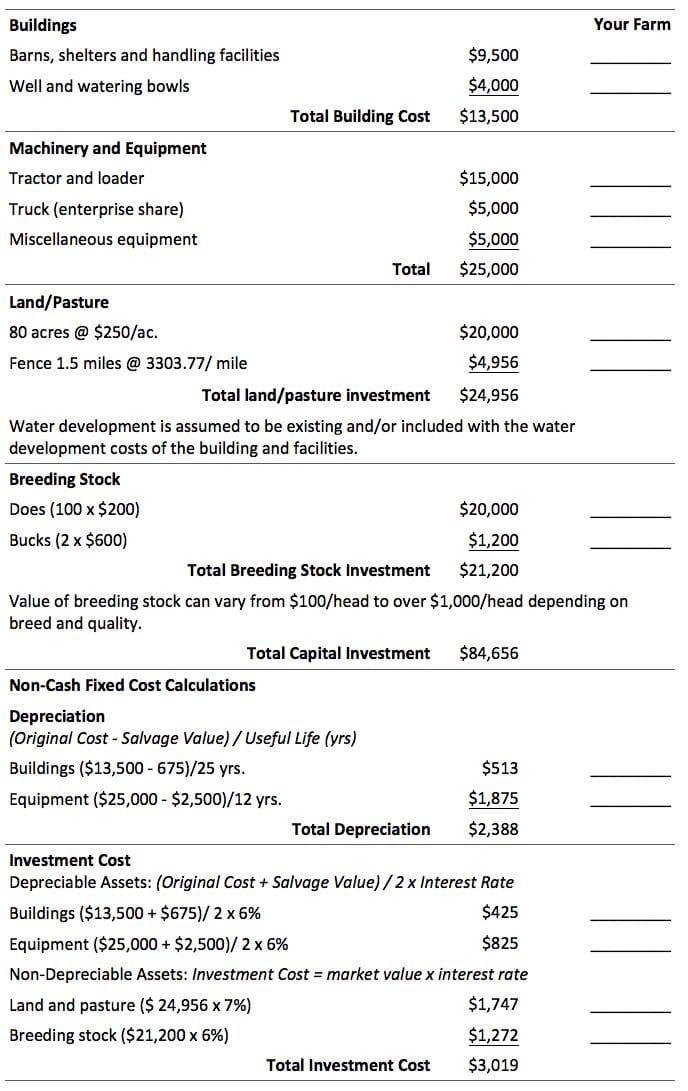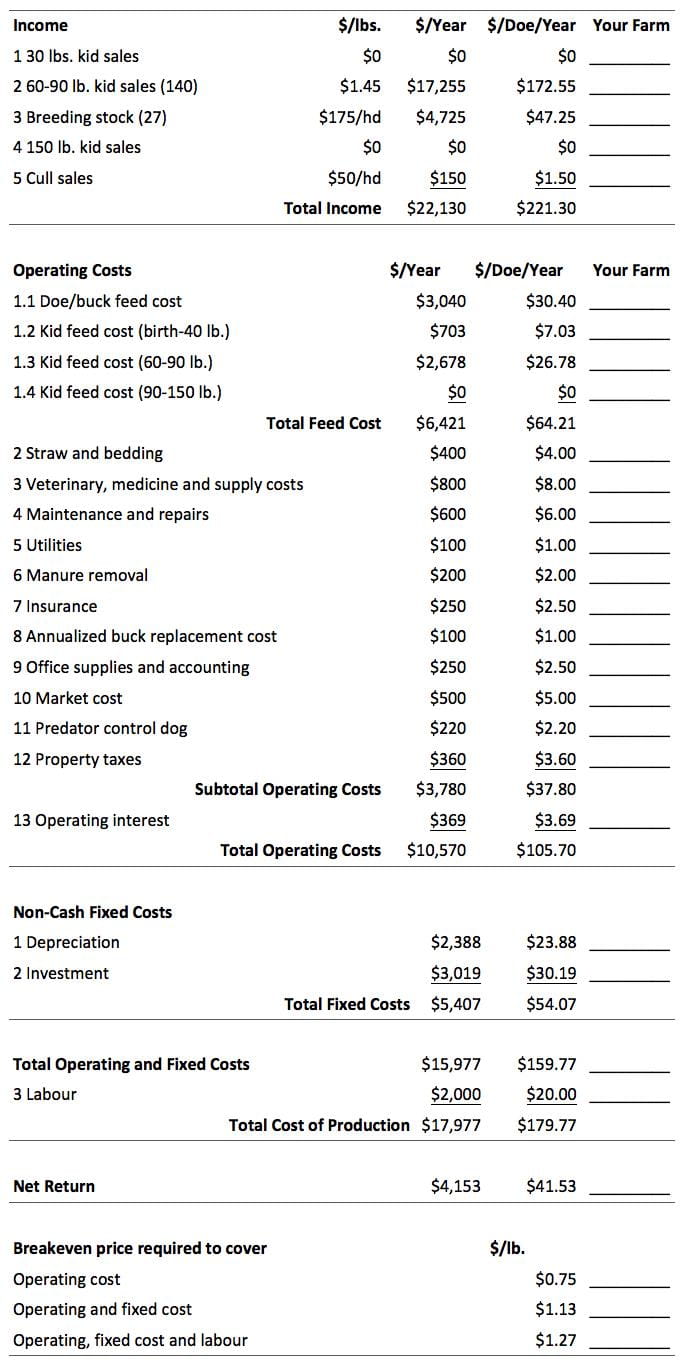This information is intended to provide a set of guidelines for determining costs of production for meat goat operations. The production costs included in these enterprise budgets are estimates based on information obtained from goat producers in the province. While these figures were considered accurate at the time, they should only be used as a guideline when preparing budgets for your own operation.
For your consideration
The benchmark figures used in the budgets are calculated for a stand-alone enterprise rather than an enterprise that is part of a multi-enterprise farm unit. In a multi-enterprise farm operation, building and equipment investment and operating costs may be shared between enterprises and could be less than what is shown in the example.
It is important to recognize that investment costs include:
- 4% return to the land,
- 6% return to buildings, equipment, and breeding stock; and
- a charge for operator management and labour has also been included.
Producers should use their own figures based on their own practices to evaluate various production alternatives to generate the greatest return from their available resources.
Market overview
While goat meat is eaten worldwide than any other type of red meat, very little of it is consumed in North America (Alberta Agriculture, 1994). However, as people continue to immigrate to North America from traditional goat consuming nations, the domestic demand for goat meat in these ethnic markets continues to increase. This ethnic demand for goat meat is derived from a number of social and religious traditions. Two main demand peaks are:/p>
- early spring; and
- late fall, which coincide with the religious holidays of Ramadam and Eid.
Demand for specific carcass sizes also varies within each market segment. The four main size classes are:
- 30 lbs.
- 60 lbs
- 90 lbs.
- 150 lbs. (above weight classes are on a live-weight basis)
Prices can vary considerably between each market so it is important for producers to understand the markets they are targeting and tailor their production to meet these standards.
Management decisions
Consider the various areas of management, including:
- Production
- Finance
- Marketing
- Human resources
Consider what classes or categories of kids are you planning on producing. This may vary with demand, timing and ability of the operator. Ask does the plan include sale of breeding stock?
Investment and financial requirements can vary substantially. Is your plan to have the goat enterprise a part of other farm enterprises, standalone, combined with off-farm employment or any combination of these? Does your lender understand the business you are financing?
Marketing decisions are important considerations. Who and where is the market? Do you have established buyers and what is the method of transaction? Are contracts or other arrangements in order? Are prices net of marketing costs and shrink or do you negotiate a price and pay all other fees?
Assumptions
- Buildings and equipment are valued at market value.
- All feed is valued at market value.
- Manure removal is contracted out.
- Five doelings are retained each year for replacements.
- Average productive life of a doe is 10 years.
- Average productive life of a buck is six years.
- On average one mature buck is required per 50 does. More bucks will be needed if young bucks are utilized.
- Does are pastured on 80 acres for 120 days after kids have been weaned.
- Kids are removed from does at three months of age and fed and/or pastured to a finished weight of 60 to 90 lbs.
| Herd Profile |
Total |
Your Farm |
| Number of does |
100 |
|
| Number of bucks |
2 |
|
| Doe mortality rate (%) |
2 |
|
| Doe cull rate (%) |
3 |
|
| Kid weaning rate (%) |
175 |
|
| Kid post-weaning mortality rate (%) |
5 |
|
| Kids marketed |
140 |
|
| Kids sold into market one (30 - 60 lbs.) |
0 |
|
| Kids sold into market two (60 - 90 lbs.) |
140 |
|
| Kids sold into market three (150 lbs.) |
0 |
|
| Breeding stock sold |
27 |
|
If using young bucks, increase the number of bucks to be used for breeding purposes.
"Kids marketed" is equal to the number of kids weaned less post-weaning mortality, doelings retained for replacements and breeding stock sales.
For this scenario, all kids are marketed at an average weight of 85 lbs. and some female stock sold as breeding stock.
Capital Investment

The number and size depicted in this fact sheet is a guide. The viability of each enterprise varies with the operator, investment, management and lifestyle required.
Income and Expense Summary for 100 Doe Commercial Enterprise

- Producers are likely to sell goats in all categories and weight ranges during a production cycle. (Lower weight kids require higher prices to cover variable and fixed costs.) We used an average weight of 85 lbs. as operations are more likely to achieve profit at this goat weight. The income figures used in this example is a gross revenue per kid.
- Doe/buck feed costs are based on three to four lbs. of hay and one to 1.5 lbs. of grain per day plus required salt and minerals. Pasture is included in fixed costs.
- Birth to 40 lbs. incorporates both a hay and prepared ration supplement. From 40 to 75 lbs. a hay, grain, mineral and salt ration is fed (3/4 to 2.5 lbs. of hay/day and 1/2 to 1 lb. of grain plus pasture).
- Marketing costs can vary with sales arrangements or contracts. This example incorporates a $19.25 marketing/transportation cost/kid. (Some contracts can be arranged with pick-up off farm.)
- Operating interest is based on 1/3 of operating costs at a nine per cent interest rate.
- Break-even price including breeding stock sales and related costs.


